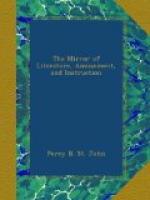THE MIRROR OF LITERATURE, AMUSEMENT, AND INSTRUCTION.
Vol. XX. No. 557.] Saturday, July 14, 1832. [Price 2d.
* * * * *
[Illustration: Birthplace of Bewick, the engraver.]
The above cottage stands in the village of Cherryburn, near Ovingham, on the banks of the Tyne, about twelve miles west of Newcastle.
In this humble dwelling, hitherto of “unlettered fame,” was born, August 12, 1753, Thomas Bewick, the celebrated artist and engraver on wood; or more strictly speaking, the reviver of this branch of art. His whole life was one of untiring industry and ardent attachment to the object of his study—the only sure passport to success—which it is truly delightful to contemplate: from the first dawnings of his early genius to the enthusiasm that led him to examine proofs of wood-engravings on the morning of his death. His life is exemplary, inasmuch as it illustrates the homely maxim, that every man is the architect of his own fortune. Apart from this consideration, the memory of Bewick should be cherished by all our readers; since he re-invented the ingenious means by which we are enabled to embellish unsparingly each of our weekly sheets.[1]
Of Bewick’s genius, and personal habits, many interesting particulars have been preserved. From his earliest years he delighted, above all things, in observing the habits of animals; and it was his fondness for this study that gave rise, while he was yet a boy, to his first attempts in drawing. Long before he had received instruction in that art, he used to delineate his favourites of the lower creation with great accuracy and spirit. His introduction to the regular study of his future profession was purely accidental. He was in the habit of exercising his genius by covering the walls and doors of the houses in his native village with his sketches in chalk. Some of these performances one day chanced to attract the attention of a Mr. Beilby, a copper-plate engraver of Newcastle, as he was passing through Cherryburn; and he was so much struck with the talent they displayed that he sought out the young artist, and obtained his father’s consent to take him with him to be his apprentice. This was in the year 1767. In the following year Bewick executed his first wood-cut for Dr. Button’s Treatise on Navigation, the diagrams for which work were, at the suggestion of Mr. Beilby, engraved on wood, and printed with the letter-press, instead of being on copper and stitched in with the sheets. Bewick executed the whole of the cuts for Dr. Button’s work with so much accuracy, and a finish so greatly beyond what had usually been attained in that species of work, that Mr. Beilby advised him to give his chief attention henceforward to wood-engraving, and make it his profession. He did so during the remainder of his apprenticeship,




